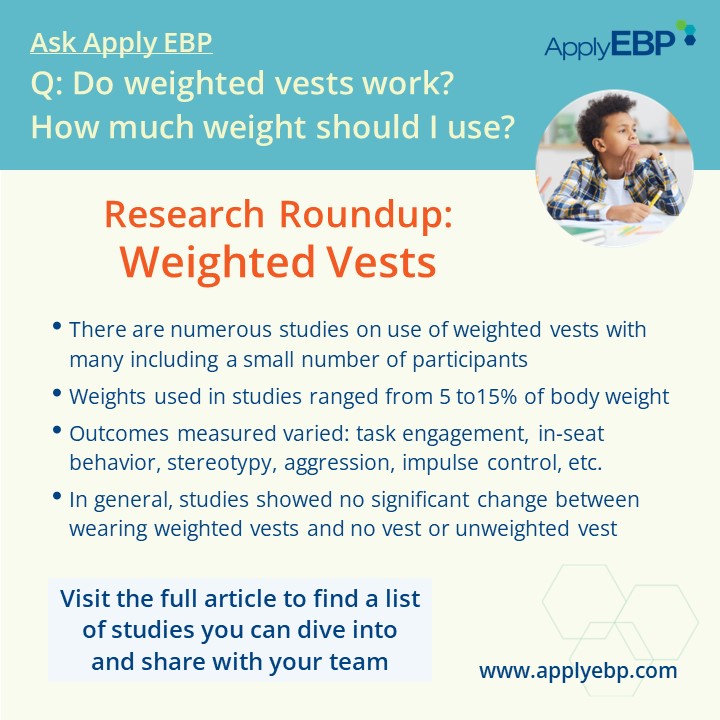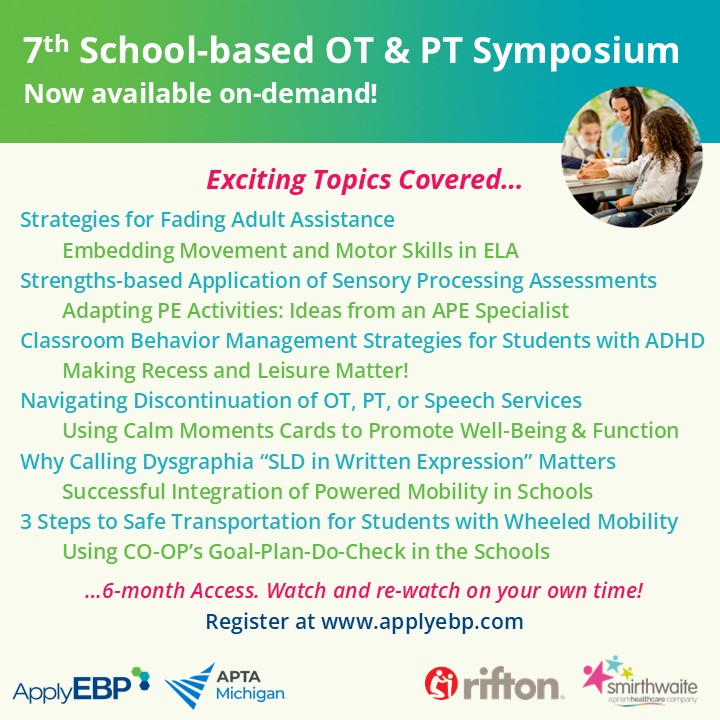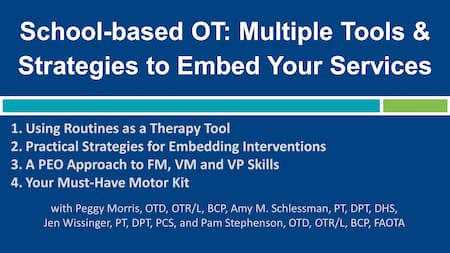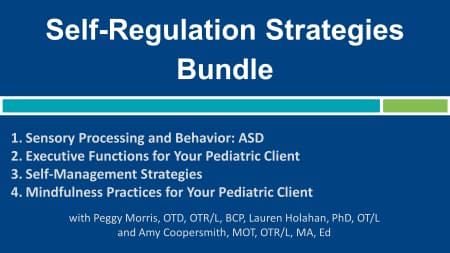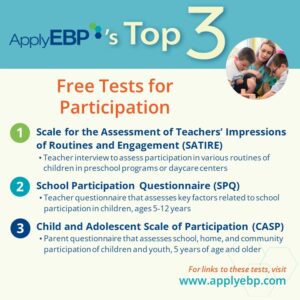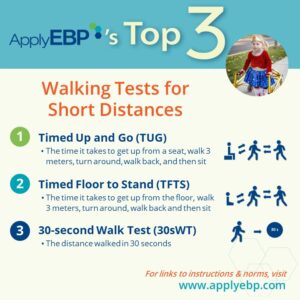Ask Apply EBP
Research Roundup: Weighted Vests
Apply EBP’s “Research Roundup” is a blog post series that serves as your go-to resource for peer-reviewed studies focusing on commonly-discussed topics relevant to OT, PT, and SLP practice. Each installment provides you a compilation of published research to inform your decision-making and to share with your team.
Q: Do weighted vests work? How much weight should I use?
In this article, we present an array of research studies on the effectiveness of weighted vests. While we provide a concise summary of the overall findings in our Big Picture Summary, we encourage you to delve into the individual articles that pique your interest for a deeper understanding.
We’ve organized the studies into two categories: Systematic Reviews (SRs), followed by other non-SR studies published since 2010 (note that there are more studies published before this date, many of which are already included in the systematic reviews). We provide key excerpts or insights from each study. All the studies we reference are sourced from peer-reviewed journals and are arranged from the most recent to the oldest.
Want a PDF Document version of this list that you can easily share with your team via print or email? Join Apply EBP’s Facebook Discussion Group by clicking here to download one.
We are committed to maintaining the relevance of this resource. If you have additional peer-reviewed research to contribute, please email it to applyebp@gmail.com with the subject “For Research Roundup” and the topic (e.g., For Research Roundup: Weighted Vests).
Thank you for your participation!
The Big Picture
-
-
- There are numerous studies on use of weighted vests with many including a small number of participants. Study participants varied, including autistic children, and children diagnosed with ADHD and developmental delays
- Weight of Vest: Studies typically used 5-10% of body weight; some used up to 15%
- Outcomes measured: different behaviors were used by the studies as outcome measures, such as task engagement, in-seat behavior, stereotypy, task completion, aggression, impulse control, etc.
- Results: In general, studies showed no significant change between wearing weighted vests from baseline, and/or no significant change when compared to no vest or unweighted vest. A small number of low to moderate quality studies with children with ADHD showed improvement in some outcome measures.
- Our take: Use other strategies that have been shown to be effective for your student’s goal. Read Apply EBP’s article: “4 Tips When Considering Interventions with Insufficient Evidence”.
-
Systematic Reviews
Ouellet, B., Carreau, E., Dion, V., Rouat, A., Tremblay, E., & Voisin, J. I. (2021). Efficacy of sensory interventions on school participation of children with sensory disorders: a systematic review. American Journal of Lifestyle Medicine, 15(1), 75-83.
-
-
- Task Engagement
- No impact in 1 study of moderate quality (ASD and developmental delays)
- No significant difference between weighted, unweighted, no vest, and pressure vest in 2 studies of moderate quality (ASD)
- No significant difference in 1 study with moderate quality (ADHD)
- Significant improvement in 3 studies with low to moderate quality (ADHD)
- In-Seat Behavior
- No difference when wearing the weighted vest as compared with baseline in 1 study of moderate quality (ASD)
- Significant improvement when wearing the weighted vest in 1 study of moderate quality (ADHD)
- Stereotyped Behavior
- No difference when wearing the weighted vest as compared with baseline in 1 study of moderate quality (ASD)
- Behavior decreased in 1 of 3 children in 1 study of moderate quality (ASD and developmental delays)
- Other variables
- Increase (significant for only 1) in behavioral problems when wearing the weighted vest in 1 study of fair to moderate quality (ASD and developmental delays)
- Positive effects were seen for task completion speed in 1 study of fair to moderate quality (ADHD)
- No effects were observed for impulse control in 1 study of fair to moderate quality (ADHD)
- Task Engagement
-
Barton, E. E., Reichow, B., Schnitz, A., Smith, I. C., & Sherlock, D. (2015). A systematic review of sensory-based treatments for children with disabilities. Research in developmental disabilities, 37, 64-80.
-
-
- “All 6 studies examining weighted vests documented no behavioral differences in conditions with or without the weighted vests.”
-
Case-Smith, J., Weaver, L. L., & Fristad, M. A. (2015). A systematic review of sensory processing interventions for children with autism spectrum disorders. Autism, 19(2), 133-148.
-
-
- “Among the seven single-subject studies that applied a weighted vest, only one demonstrated positive effects. Although these studies provide low-level evidence, findings suggest that wearing a weighted vest does not result in improved behavior (e.g. decreased stereotypic behaviors, improved joint attention, or reduced distractibility).”
-
Taylor, C. J., Spriggs, A. D., Ault, M. J., Flanagan, S., & Sartini, E. C. (2017). A systematic review of weighted vests with individuals with autism spectrum disorder. Research in Autism Spectrum Disorders, 37, 49-60.
-
-
- “The results of the review show that the use of WV [weighted vests] with individuals with ASD is not an evidence-based practice.”
-
Quigley, S. P., Peterson, L., Frieder, J. E., & Peterson, S. (2011). Effects of a weighted vest on problem behaviors during functional analyses in children with pervasive developmental disorders. Research in Autism Spectrum Disorders, 5(1), 529-538.
-
-
- There was no functional relationship between the use of 5% or 10% weighted vests and participants’ challenging behaviors.
-
Stephenson, J., & Carter, M. (2009). The use of weighted vests with children with autism spectrum disorders and other disabilities. Journal of autism and developmental disorders, 39, 105-114.
-
-
- “Seven studies [from 2001-2007] examining weighted vests are reviewed. While there is only a limited body of research and a number of methodological weaknesses, on balance, indications are that weighted vests are ineffective.”
-
Other Studies Published since 2010 (Non-systematic reviews)
Macphee, F. L., Merrill, B. M., Altszuler, A. R., Ramos, M. C., Gnagy, E. M., Greiner, A. R., … & Pelham, W. E. (2019). The effect of weighted vests and stability balls with and without psychostimulant medication on classroom outcomes for children with ADHD. School Psychology Review, 48(3), 276-289.
-
-
- “Overall, results indicated that medication but not weighted vest nor stability ball interventions resulted in improvement in two key areas of functioning in school settings: following classroom rules and academic productivity.”
-
Lin, H. Y., Lee, P., Chang, W. D., & Hong, F. Y. (2014). Effects of weighted vests on attention, impulse control, and on-task behavior in children with attention deficit hyperactivity disorder. The American Journal of Occupational Therapy, 68(2), 149-158.
-
-
- “Participants did show significant improvement in all three attentional variables of the CPT–II task, including inattention; speed of processing and responding; consistency of executive management; and three of four on-task behaviors, including off task, out of seat, and fidgets. No significant improvements in impulse control and automatic vocalizations were found.” (110 children with ADHD)
-
Davis, T. N., Dacus, S., Strickland, E., Copeland, D., Chan, J. M., Blenden, K., … & Christian, K. (2013). The effects of a weighted vest on aggressive and self-injurious behavior in a child with autism. Developmental neurorehabilitation, 16(3), 210-215.
-
-
- “The results do not suggest the existence of a functional relationship between the use of a weighted vest and challenging behavior, as the weighted vest had no marked effect on levels of aggression and self-injurious behavior.”
-
Hodgetts, S., Magill-Evans, J., & Misiaszek, J. (2011). Effects of weighted vests on classroom behavior for children with autism and cognitive impairments. Research in Autism Spectrum Disorders, 5(1), 495-505.
-
-
- Four (4) children “demonstrated no objective improvements.” Six (6) children “who did demonstrate objective and subjective improvements in behavior still had high rates of off-task behavior with the weighted vests.”
-
Hodgetts, S., Magill-Evans, J., & Misiaszek, J. E. (2011). Weighted vests, stereotyped behaviors and arousal in children with autism. Journal of autism and developmental disorders, 41, 805-814.
-
-
- “Based on this protocol, the use of weighted vests to decrease stereotyped behaviors or arousal in children with autism in the classroom was not supported.”
-
Collins, A., & Dworkin, R. J. (2011). Pilot study of the effectiveness of weighted vests. The American Journal of Occupational Therapy, 65(6), 688-694.
-
-
- “Our results indicated that the weighted vests were not effective in increasing time on task.”
-
Leew, S. V., Stein, N. G., & Gibbard, W. B. (2010). Weighted vests’ effect on social attention for toddlers with autism spectrum disorders. Canadian Journal of Occupational Therapy, 77(2), 113-124.
-
-
- There were no replicated effects of vests on competing behaviours or joint attention. Mothers experienced increased morale in spite of null effects of the intervention.
-
Reichow, B., Barton, E. E., Sewell, J. N., Good, L., & Wolery, M. (2010). Effects of weighted vests on the engagement of children with developmental delays and autism. Focus on Autism and Other Developmental Disabilities, 25(1), 3-11.
-
-
- “The results showed no differentiation in engagement between conditions for any of the participants.” The three different conditions were “weighted vest (5% weight), vest with no weight (which served as a placebo), and no vest (which served as a baseline).”
-
If you are interested in more evidence-based discussions about decision-making and embedded services…
Or these webinars…
Find More Answers to Your Questions in Our...
Featured School
Symposium
7th Online School-based OT and PT Symposium - On-Demand Version
- Watch and re-watch on your own time
- On-Demand Version
- OTs, OTAs, PTs and PTAs
- $399-449
Featured Live
Workshop
6th Online School-based OT and PT Symposium - On-demand Version
- Watch and re-watch on your own time
- On-Demand Version
- OTs, OTAs, PTs and PTAs
- $399-449
Featured On-Demand
Webinar
Self-Management Strategies
Featured Webinar
Bundle
Self-Regulation Strategies Bundle
Have a question?
Submit here…
*Clicking submit will send your question directly to our email inbox. Your name and email will let us know that your submission is real (not spam). We will not include these in our posts, unless you tell us to include your name. Please read our privacy policy here.
All infographics and videos on www.applyebp.com are intellectual properties of Apply EBP, LLC
You may use the infographics and videos for free for any non-commercial, educational purposes. Please cite the source as “Apply EBP, LLC” and a link to the source article. If you plan to use any infographic or video for commercial purposes (i.e., for profit), please email Carlo@applyebp.com to obtain a written permission. Permission can be granted on a case-by-case basis.

